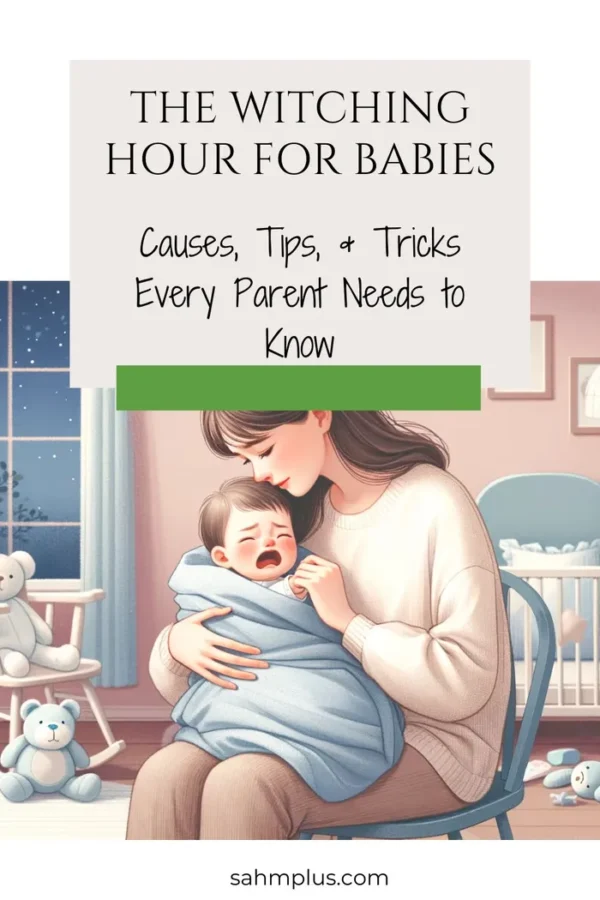Unless your darling is the epitome of all things good in the world, you’ve likely experienced (or are currently experiencing) the dreaded witching hour for babies.
It sounds just as ominous as it feels—a time when blissful evenings crumble into chaos, leaving both you and your baby on the brink of exhaustion.
As a mother of two, I’ve had my fair share of experiences when it comes to dealing with the unpredictable nature of the witching hour. I’m here to share insights and strategies that have helped me turn this challenging time into an opportunity for connection and bonding.

What Is the Witching Hour for Babies?
The witching hour, sometimes called the period of purple crying, is a time in the late afternoon or evening when a baby starts to cry seemingly for no reason.
The exact period differs from baby to baby, but it usually happens between 6 p.m. and 11 p.m. and lasts anywhere between a few hours till the early morning. It isn’t unusual for it to occur earlier or later, depending on your baby’s temperament, age, and feeding schedule.
In my own experience, my second born began his witching hour at about 5pm every evening.
According to Dr Luke Voytas, pediatrician and author of Beyond the Checkup, the witching hour typically starts at two weeks old and peaks at six to eight weeks and usually disappears completely in three to five months.
The witching hour is characterized by a set of behaviors, including:
- Excessive, loud, and seemingly inconsolable crying
- Restlessness
- Difficulty sleeping
- Arching back or clenching fists, as though in pain
- Difficulty feeding
- Vigorous sucking, whether on a pacifier, fingers, or during breastfeeding
What Causes the Witching Hour?
The witching hour isn’t an official medical term with a precise definition or diagnostic criteria. As such, the reasons that cause it remain somewhat elusive.
Here are some potential reasons that trigger it:
Overstimulation
After spending the first nine months in the comfort and warmth of your belly, the “outside world” becomes a sensory-rich and stimulating environment for a newborn.
All of a sudden, he’s overwhelmed with an influx of new sights, sounds, smells, and sensations—not a fun time!
And when evening comes, the bubble bursts. He’s had too much and lets you know through crying.
Fatigue and Frustration
Babies demonstrate self-soothing behaviors by three to four months.
Before that, though, they’re like a fish out of water, unable to regulate their nervous system when it’s time to wind down. This can lead to fussiness and frustration from being unable to sleep. They cry to not only express discomfort but also seek comfort from their parents.
Hunger
Sometimes, babies fuss during the witching hour because they’re hungry.
This hunger aligns with a behavior called cluster feeding, where a baby wants lots of short feeds over a few hours—sometimes as often as 30 minutes.
It’s common and normal, especially during the early days of breastfeeding.
Circadian Rhythm Development
In the early months of their lives, babies are still developing their circadian rhythm, which regulates sleep-wake cycles.
The witching hour may coincide with the baby’s internal clock being out of sync with the family’s daily routine.
As the baby’s circadian rhythm matures, the intensity of the witching hour often decreases.
Trapped Wind
If a baby isn’t well-winded after his feeds, gas could build up throughout the day. By the early evening, that trapped wind can become a source of discomfort, causing him to cry, writhe, and call out for your attention.
Reflux
During their early months, many babies experience reflux.
Reflux happens when the contents of the baby’s stomach, including the stomach acid, flow back into the esophagus. It usually happens during or shortly after feeding, but it can also occur one to two hours later.
During the witching hour, babies with reflux may experience heightened discomfort.
The horizontal position during feeding or cuddling, common during the witching hour, can also trigger reflux symptoms.

What Is the Difference Between the Witching Hour and Colic?
Although the symptoms of the witching hour and colic appear identical, they’re not the same thing.
For one, the witching hour isn’t an official medical term or diagnosis; rather, it’s an expression parents use to describe a phase of increased fussiness and crying.
Meanwhile, colic is a medical term indicating severe abdominal pain due to factors like intestinal gas or muscle spasms. It involves prolonged and intense crying, usually more than three hours a day for more than three days a week, and more than three weeks in a row.
In comparison, the witching hour is characterized by periods of fussiness, on and off throughout the evenings. It can be caused by colic, as well as other factors such as overstimulation or hunger.
Witching Hour vs Colic
| Feature | Witching Hour | Colic |
|---|---|---|
| Crying Duration | Short periods, interspersed with calm moments | Prolonged crying (3+ hours/day) |
| Crying Intensity | Moderate | Intense, inconsolable |
| Frequency | Daily, usually in late afternoon/evening | Daily, often at various times |
| Responsiveness to Soothing | Somewhat responsive to calming techniques | Less responsive to soothing |
| Age Onset | Around 2 weeks, peaks at 6-8 weeks | Around 2-3 weeks, resolves by 3-4 months |
| Duration | Fades by 3-5 months | Usually resolves by 3-4 months |
| Cause | Overstimulation, fatigue, hunger, developing sleep cycles | Unknown, may involve gas, muscle spasms, immature digestive system |
| Medical Intervention | Not usually needed | Consult a pediatrician to rule out medical conditions |
Additional Points:
- Witching hour is a normal developmental phase, while colic is a medical condition.
- If unsure about the cause of your baby’s crying, consult your pediatrician.
How to Prevent or Reduce Fussiness During the Witching Hours
Here are some strategies that can help prevent or reduce the intensity of the witching hour:
1. Watch for Early Signs of Sleepiness
Don’t wait until your baby is overtired when putting him to bed.
Be attentive to early signs of sleepiness (or sleepy cues); if your little one is yawning, rubbing his eyes, or becomes less engaged, it’s time to start the bedtime routine.
Remember I told you my second baby went through his witching hour at about 5pm every night?
By paying attention to the consistency of the timing, I was able to get ahead of the fussiness and start the bedtime routine before he became inconsolable and overtired.
2. Create a Bedtime Routine
Establish a consistent routine to help them understand that bedtime is approaching.
Create a predictable sequence of activities that can help soothe your baby, whether it’s a bedtime story, a warm bath, or a gentle lullaby.
Use the same techniques when your baby appears agitated during the witching hour so he associates them with safety and relaxation.
3. Adjust Feeding Patterns
If your baby tends to cluster feed during the witching hours, try to adjust the feeding patterns earlier in the evening. Offer more frequent but lesser feedings leading up to bedtime to help satisfy your baby’s hunger and also prevent reflux.
4. Reduce Stimuli
Minimize stimuli during the witching hours by creating a calm and dimly lit environment.
Lower the lights, reduce noise, and put on some calming music to help your baby wind down and get ready to sleep.
Babies love the feeling of skin-to-skin, so you can also use this time to give your little one a gentle massage.
The witching hour can be a difficult and frustrating time for both the parent and the infant. However, it’s important to understand that it’s a passing phenomenon that improves as babies grow and adapt to their surroundings.
As caregivers, understanding the factors that trigger the witching hour allows us to implement the necessary steps and strategies to create a more soothing environment for our little ones.
Think of the witching hour as a training exercise for your superhero skills. You’ll master the art of calming cries, decipher fussy codes, and emerge victorious, ready to conquer any bedtime battle. So, chin up, cape on, and remember, even superheroes need a cuddle break sometimes.
FAQs About The Witching Hour For Babies
How do I stop my baby’s witching hour?
There’s no magic solution, but some strategies can help:
Timing: Watch for early sleepiness & establish a calming bedtime routine.
Comfort: Dim lights, reduce noise, try swaddling, skin-to-skin, calming sounds.
Feeding: Adjust feeding to avoid hunger during witching hour, consider cluster feeding.
Patience: Stay calm, offer cuddles, understand it’s temporary.
What age do babies have a witching hour?
It typically starts around 2 weeks, peaks at 6-8 weeks, and fades by 3-5 months.
Why does my baby cry at the same time every evening?
Your baby could be developing sleep-wake cycles, or experiencing overstimulation, hunger, or reflux.
Why is 6 weeks the peak of fussiness?
Several factors contribute: immature nervous system, adjusting to the world, hunger patterns, developing circadian rhythm.


1 comment
Really enjoyed the article, it’s very helpful for me.
Comments are closed.